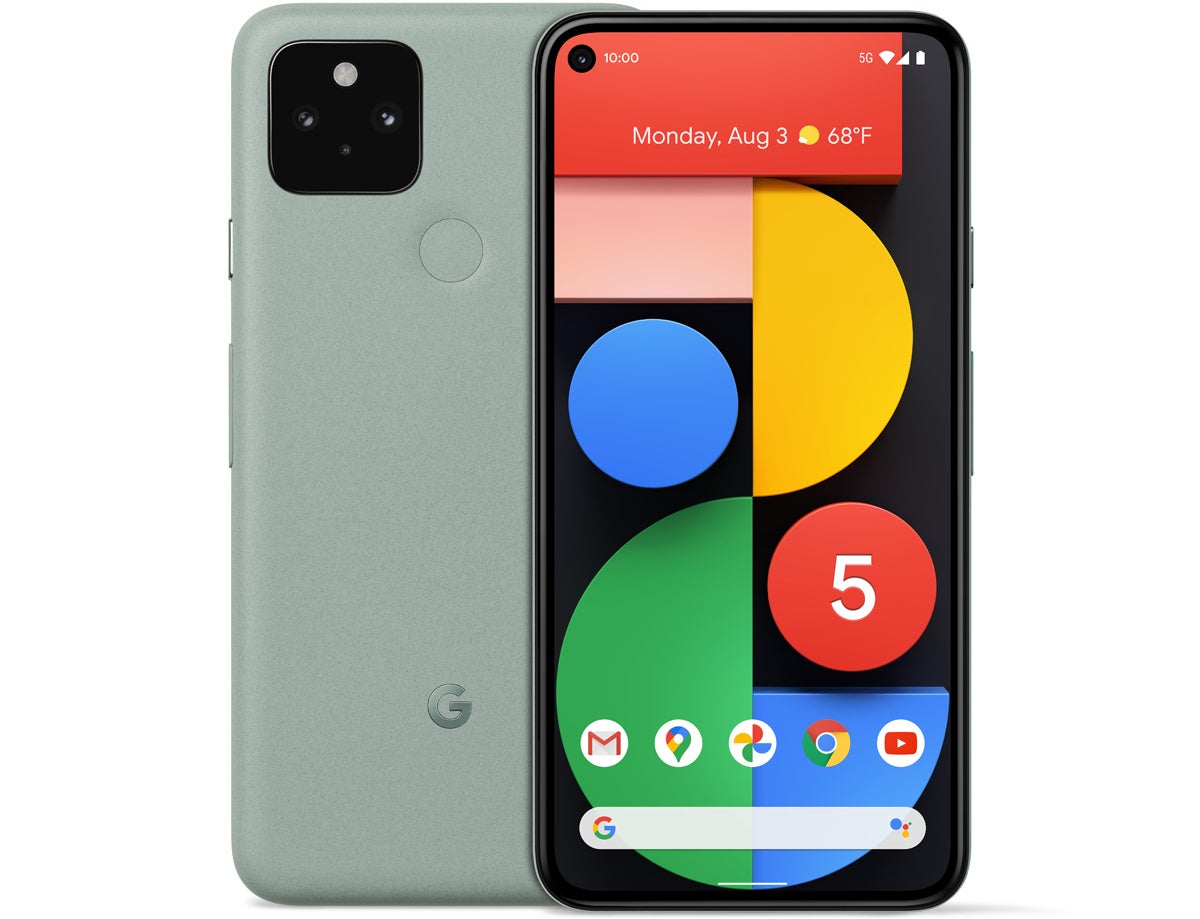It's a weird year for Pixel phones.
I've been spending some time with Google's current trio of homemade Android devices — the flagship Pixel 5, the budget-minded Pixel 4a, and the confusingly in-between Pixel 4a (5G) — and lemme tell ya: This isn't your typical Pixel lineup.
Between Google's pivot to a more value-minded approach and the midyear manufacturing delays caused by this lovely little pandemic of ours, the Pixel family of 2020 ended up looking pretty different than what we've grown accustomed to expecting. And if you're thinking of picking up a new Pixel phone for yourself or your workplace, it's more than a little difficult to sort out which model makes the most sense for any given purpose and whether it's a worthwhile upgrade from an older Pixel model.
Having lived with all three 2020 Pixel phones now, I think I've sorted out what the lineup's actually all about, why it's so damn confusing, and how you can know which specific Pixel option is (or isn't!) right for you.
Let's break it all down, shall we?
Pixel 5, Pixel 4a, and Pixel 4a (5G): Reframing and renaming the phones
Part of the reason this Pixel lineup is so tricky to process, I think, is that the phones' names don't make much sense.
In carrying around all three current Pixel models, here's what I've come to realize: For all intents and purposes, the Pixel 5, Pixel 4a, and Pixel 4a (5G) are three versions of the same device. Once you start thinking about 'em in that light, they're a lot easier to understand.
I'm gonna give you new, more sensible names for two out of three of those products, in fact, but let's start at the top: The Pixel 5 is the flagship — the top-tier model of the three. That part's pretty obvious, right? The difference is that compared to past Pixel flagships, it's a little less high end and thus also less expensive, with a starting price of $699 — barely more than the original Pixel phone cost in 2016 (and I'm sure I don't have to tell you how much phone prices in general have skyrocketed since then).
 Google
Google
Google's Pixel 5 phone, in its distinctive "Sorta Sage" color.
The interesting thing is that most of the Pixel 5's cost-cutting measures aren't especially consequential; quite honestly, hardly any regular phone owners are gonna notice the real-world, practical difference between, say, the top-of-the-line Snapdragon 865 processor present in most 2020 flagships and the less expensive Snapdragon 765G chip in the Pixel 5 — or between the excessively high-resolution screens some high-end smartphones possess and the excellent-looking 1080p screen the Pixel 5 relies on.
By and large, the Pixel 5 is just a delight to use. It feels like a high-end, flagship-worthy phone, and it has all of the positives you'd expect from a top-of-the-line Pixel — a premium-feeling build, yes, but more importantly, that unmuddled Google Android experience that makes most other Android phones look like gently warmed garbage in comparison. It's not just assets like the clean and simple user interface and the presence of tight Google app integration but also the Pixel line's lack of bloatware, lack of built-in spammy ads, and lack of shady data-selling systems (!). Factor in the best-in-class camera experience and the unmatched three-year guarantee of near-instant operating system and security updates, and it's a phone that stands in a league of its own — for business use and personal use alike.
But wait! Most of those same advantages are also present in the $349 Pixel 4a — which I'd reframe in your mind as the Pixel 5 Lite. The two phones are clearly siblings, with the same basic size, the same exact form and style of design, and the same software and overall experience. The 4a's body is made of plastic instead of aluminum, which makes it less premium and fancy-feeling but definitely doesn't make it come across as cheap. It's the soft-touch kind of plastic treatment — the good way to do plastic, in other words, not the chintzy toy-like approach we used to see in certain early smartphones.
 Google
Google
The understated but outstanding Pixel 4a phone.
Under the hood, the 4a has more limited processing power than its higher-end sister, but lemme tell ya: The phone feels smooth and snappy in day-to-day use, and the vast majority of phone owners are never gonna think twice about what's under its hood. The camera setup is mostly the same as what the 5's got goin', too, with the only real difference being the lack of an ultrawide lens.
Beyond that, the 4a has a lower refresh-rate screen than the 5, which will be massively significant to a small number of people and mostly irrelevant to everyone else, and it lacks wireless charging and water resistance — both extras the Pixel 5 offers but that most average phone owners aren't gonna miss.
And then there's the Pixel 4a (5G) — the most baffling member of this year's Pixel family. I'd think of it as the Pixel 5 Lite+, a more powerful and slightly larger version of the regular Pixel 4a.
For $499, the 4a (5G) gives you a plastic body that's more or less identical to the 4a's exterior along with higher-end internals that are closer to what the Pixel 5 provides, although with some weird asterisks attached. The phone uses the same processor as the Pixel 5, for instance, but has the same amount of RAM as the Pixel 4a. It has the ultrawide lens like the Pixel 5 but has the lower-refresh-rate display like the Pixel 4a. And as I mentioned a second ago, it's also a little bit bigger than either phone, just to add another random-seeming factor into the mix.
 Google
Google
The clunkily named and awkwardly positioned Pixel 4a (5G).
And, yes, both the Pixel 5 and the Pixel 4a (5G) have 5G, which the regular Pixel 4a does not. But that's more about marketing hype and appeasing the carriers than anything at this point. If you think having 5G on your phone is gonna be a transformational advantage in your day-to-day life, well, sorry to be the bearer of bad news, but you've got a nasty surprise coming. I'm not even going to treat the presence or absence of 5G as a relevant factor to consider — because right now, with very little and extremely limited exception, it just isn't.
Got all that? Good. Now, let's make it even more black and white and talk about which 2020 Pixel model is actually worth your while.
Pixel 5 vs. Pixel 4a vs. Pixel 4a (5G): Which to buy and why
Here's the short 'n' simple, no-nonsense breakdown:
- The Pixel 5 provides the top-tier, best possible all-around Android experience you can get today. This is the Android phone I'd recommend for anyone who appreciates more premium-feeling hardware, wants to have niceties like wireless charging and water resistance, and/or wants enhanced processing power for the snappiest available performance — and doesn't mind paying a little extra for that step-up option.
- The Pixel 4a — or what I'd think about as the Pixel 5 Lite — gives you the same experience as the Pixel 5 with a less premium body, less processing power, and fewer hardware-based bells and whistles. This is the Android phone I'd recommend for most people right now, as it'll have more than enough oomph for the vast majority of folks, and it offers an almost insane level of value. And I really think most casual, non-power-user phone owners would struggle to notice the meaningful, practical differences between it and the Pixel 5, in both form and performance.
- The Pixel 4a (5G) — or what I'd think about as the Pixel 5 Lite+ — is the awkward middle child of 2020's Pixel trio. It has the Pixel 4a's form in a slightly larger body and with some of the Pixel 5's under-the-hood advantages. I guess this phone could make sense if you want the extra processing power or really want that ultrawide camera lens but need a lower price than the Pixel 5? It's a fine phone, really, and a commendable one; I just have a tough time figuring out why it exists in this lineup and why anyone should buy it, specifically.
Put simply, the 4a is the best all-around option for most people — and if you want a step up from there, the 5 makes the most sense. I certainly wouldn't advise against getting the 4a (5G), if it speaks to you; it just strikes me as a rather small and unusual niche of people for whom it's the most appropriate option.
Now, there's just one more bit of complication with this Pixel lineup — and that's in the area of upgrading from an older Pixel model.
The Pixel upgrade conundrum
I won't beat around the bush: As someone who's owned and used a Pixel 4 for the past year, the Pixel 5 feels kind of like a step down from that device in most practical measures — almost like the phone that should have come before it instead of after it.
That's probably an unavoidable consequence of Google shifting from a top-tier, high-priced approach with the Pixel 4 to a more value-minded strategy with the Pixel 5. But it creates an awkward situation for anyone who already owns last year's phone and is thinking about upgrading.
Most notably, the Pixel 5 loses the Pixel 4's spectacular face unlock system — something that might not seem like much on paper but that's a hugely useful asset when you have it in your life. Granted, our current mask-wearing reality takes some of the value out of such a system, but with any luck, this situation won't last forever. And as a Pixel 4 owner myself, giving up face unlock absolutely isn't something I'd want to do right now.
The 5's metal vibe is plenty nice, meanwhile, but it feels a touch less luxurious than the 4's soft-treated glass exterior. Its speakers are noticeably worse. And while the 5 does have smaller bezels around its screen than its predecessor, that means it has a hole-punch-sized cutout in the corner of its display — something that, popular narrative be damned, I maintain is an inferior, disadvantageous setup compared to a wholly present screen.
(That's a whole other soapbox, but in short, think about it: Would you rather have a subtle border around your display or have a frickin' piece of blacked-out content within the part of the phone where you actually spend all your time looking — viewing photos, reading documents, scrolling through websites, and so on? The industry stance on this is just plain wrong.)
The one meaningful, noticeable area where the 5 comes out ahead of the 4 in real-world usage is in battery life — so there's that. But all in all, it seems like somewhere between a lateral move and a practical downgrade. Unless battery life is enough of an issue for you on the Pixel 4 that you're willing to sacrifice everything else in exchange for an improvement in that area, it's not a move I'd recommend making.
What about coming from the Pixel 3 generation of phones? Well, there, you have an even more distracting display cutout, so going from that to the hole-punch setup is actually a step in the right direction. You also don't have face unlock on the Pixel 3 phones, so moving to another device without that isn't such a big deal.
Again, battery life is probably the area where you'll see the biggest realistic difference. When you put it all together, I'd say this: The Pixel 5 or really any of the current Pixel models would be a modest improvement and a nice little upgrade if you're itching for something new or no longer happy with your current phone's condition. As long as your current device is still in decent shape and performing well, though, I'd have a tough time telling you what meaningful and significant real-world improvements you'll notice from making such a change — especially when you've got a full year of active software support left on your current model.
Last but not least, with the Pixel 2 generation of phones or the first-gen Pixels, it's easy: Do it. Make the purchase. Your device is now out of its window of active software support, which means you won't be getting any more updates. And your phone is old enough that you'll see some very noticeable differences with any of the current Pixel options.
So there we have it: the state of Google's 2020 Pixels — exceptional phones, in and of themselves, that are caught in the middle of an awkward transition and made even more murky by their pandemic-caused positioning. I genuinely do think Google's shift toward a more value-oriented phone strategy is a smart gamble and one that's likely to pay off in the long run, both for Google and for us as land-roving creatures who buy and tote around these gadgets.
For now, though, we have to deal with the transition and confusion that inevitably goes along with such a shift. It's a weird year. But with any luck, in the grand scheme of things, it'll be a small price to pay and a short-term path to something even better.
Want even more Googley knowledge? Sign up for my weekly newsletter to get next-level tips and insight delivered directly to your inbox.

[Android Intelligence videos at Computerworld]












































